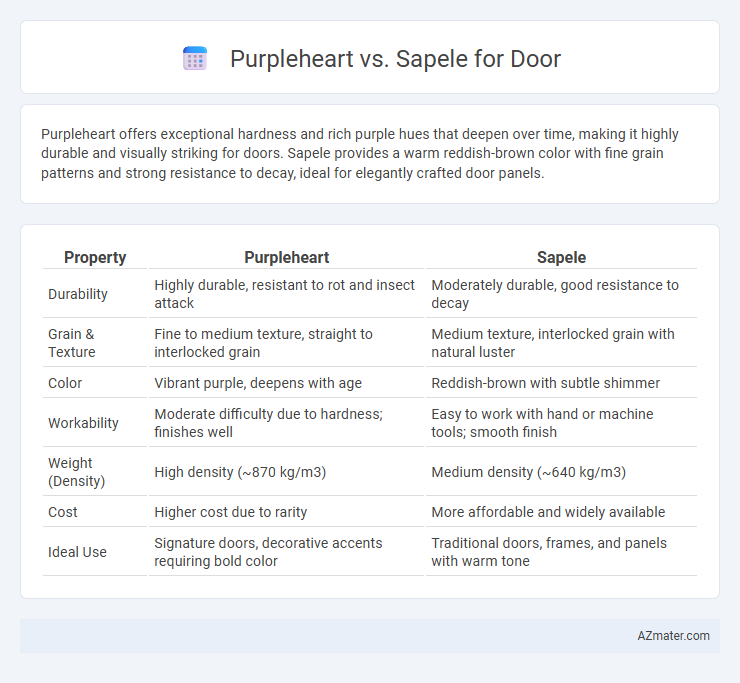Purpleheart offers exceptional hardness and rich purple hues that deepen over time, making it highly durable and visually striking for doors. Sapele provides a warm reddish-brown color with fine grain patterns and strong resistance to decay, ideal for elegantly crafted door panels.
Table of Comparison
| Property | Purpleheart | Sapele |
|---|---|---|
| Durability | Highly durable, resistant to rot and insect attack | Moderately durable, good resistance to decay |
| Grain & Texture | Fine to medium texture, straight to interlocked grain | Medium texture, interlocked grain with natural luster |
| Color | Vibrant purple, deepens with age | Reddish-brown with subtle shimmer |
| Workability | Moderate difficulty due to hardness; finishes well | Easy to work with hand or machine tools; smooth finish |
| Weight (Density) | High density (~870 kg/m3) | Medium density (~640 kg/m3) |
| Cost | Higher cost due to rarity | More affordable and widely available |
| Ideal Use | Signature doors, decorative accents requiring bold color | Traditional doors, frames, and panels with warm tone |
Introduction to Purpleheart and Sapele Wood
Purpleheart wood, known for its vibrant purple hue and exceptional durability, is a popular choice for doors that demand both aesthetic appeal and strength. Sapele wood, originating from West Africa, offers a rich reddish-brown color with a fine, interlocking grain that enhances door stability and visual warmth. Both woods provide excellent resistance to wear and environmental factors, making them ideal for high-quality door construction.
Botanical Origins and Distribution
Purpleheart, sourced from the Peltogyne genus native to Central and South America, thrives predominantly in tropical rainforests of Brazil and Guyana. Sapele, a member of the Meliaceae family from the Entandrophragma genus, primarily grows in West African countries like Ghana and Ivory Coast. Both woods are valued for door crafting due to their distinct botanical origins influencing grain patterns and natural durability.
Appearance: Color, Grain, and Texture
Purpleheart wood boasts a vibrant, rich purple hue that deepens to a dark brown with age, offering a striking and unique appearance ideal for doors seeking distinction. Sapele exhibits a warm, reddish-brown color with a golden sheen, featuring interlocked, wavy grain patterns that create a visually dynamic texture. Both woods present smooth, fine textures, but Purpleheart's bold color contrasts sharply against Sapele's classic elegance, influencing aesthetic choices in door design.
Durability and Resistance to Elements
Purpleheart wood exhibits exceptional durability and resistance to moisture, making it highly suitable for exterior door applications where exposure to weather is frequent. Sapele offers good stability and moderate resistance to decay but is generally less durable than Purpleheart when subjected to prolonged elemental exposure. Choosing Purpleheart over Sapele ensures enhanced longevity and better performance in harsh environmental conditions for door construction.
Workability and Ease of Machining
Purpleheart wood offers moderate workability but can be challenging due to its density and interlocked grain, often requiring sharp tools and slower feed rates for smooth machining. Sapele is prized for its excellent workability, with a fine, even texture that machines smoothly and finishes well, making it a preferred choice for detailed door construction. Both woods are durable, but Sapele generally provides easier handling and cleaner cuts, reducing tool wear and effort during door fabrication.
Cost and Availability
Purpleheart wood tends to be more expensive and less readily available compared to Sapele, largely due to its exotic origin and limited supply. Sapele is widely accessible and more cost-effective, making it a popular choice for door construction without compromising on durability. Choosing Sapele often results in lower material costs and easier procurement, while Purpleheart offers a distinct, vibrant hue at a premium price point.
Environmental Impact and Sustainability
Purpleheart and Sapele differ in environmental impact and sustainability, with Purpleheart sourced mainly from South American rainforests, raising concerns over deforestation and habitat loss due to high demand and limited regulations. Sapele, harvested primarily from West African forests, is often managed under stricter forestry certification schemes like FSC, promoting sustainable logging practices and reduced ecological damage. Choosing Sapele for door construction supports better sustainability credentials and lower environmental footprints compared to Purpleheart, given responsible sourcing.
Maintenance and Longevity of Doors
Purpleheart doors offer exceptional durability and natural resistance to decay and insects, resulting in low maintenance requirements and a lifespan of over 25 years with proper care. Sapele doors provide good strength and a moderate level of rot resistance but may need periodic sealing or refinishing to maintain appearance and protection against moisture. Choosing Purpleheart ensures extended longevity and minimal upkeep, ideal for high-traffic or exterior door applications.
Best Use Cases for Purpleheart and Sapele Doors
Purpleheart doors excel in high-traffic and exterior applications due to their exceptional durability, resistance to decay, and vibrant purple hue that darkens with age, making them ideal for striking entry doors and feature interior doors. Sapele doors are best suited for elegant interior applications where a rich, warm mahogany-like appearance is desired, offering fine grain patterns and stability that enhance cabinetry, closet doors, and upscale wooden room doors. Both woods provide excellent machinability, but Purpleheart's superior hardness makes it preferable for doors requiring enhanced impact resistance and long-term weather endurance.
Final Verdict: Choosing the Right Wood for Your Door
Purpleheart offers exceptional durability and a vibrant purple hue that deepens over time, making it ideal for statement doors that require both strength and bold aesthetics. Sapele provides a warm, reddish-brown color with a fine grain and excellent workability, perfect for doors seeking a classic, elegant appearance with natural resistance to decay. For long-lasting impact and vivid color, Purpleheart is the superior choice, while Sapele suits those desiring a timeless, refined look with reliable durability.

Infographic: Purpleheart vs Sapele for Door
 azmater.com
azmater.com